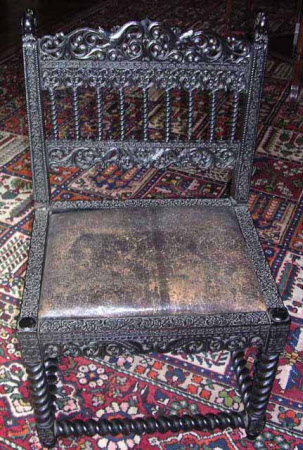Chair
Category
Furniture
Date
circa 1660 - 1680
Materials
Ebony, leather
Measurements
93 x 55.3 cm
Place of origin
Coromandel Coast
Order this imageCollection
Tyntesfield, North Somerset
NT 20196.1
Summary
A carved and pierced ebony chair, or backstool, Coromandel Coast, India, circa 1660-80. The chair 20196.1, the later leather seat (it would originally have been cane) 20196.2. Topped by an arched and shaped cresting formed from pierced scrolls, above a back of nine spiral-turned spindles with pierced capitals, the bottom rail centred by a winged mask between foliated scrolls. All between uprights topped by bird-form finials. The later leather-lined set in carved rails, all above a front seat rail centred by addorsed bird's amidst scrolls. The legs block and spiral-turned, and on turned feet. The rails and rear uprights profusely carved with meandering vies and stalked leaves.
Full description
Chairs like this of carved and turned ebony were made in south-eastern India, in states bordering the Bay of Bengal on what is now called the ‘Coromandel’ Coast. Rich in natural resources, the area attracted European trading interest from the middle of the 17th century and this led to the emergence of a market in carved ebony furniture – heavily influenced by Dutch fashions – of which there are several examples in National Trust collections. These chairs are an interesting amalgam: the form, particularly the spiral-turned legs, is typically European, but the carved flora are species indigenous to India and their abundance on these chairs typical of the 17th century Indian aesthetic.There are six of this type of chair at Tyntesfield (this is the only open armchair), a house remodelled and furnished with a fortune amassed by William Gibbs (1790-1875), ‘the richest commoner in England’, directly from the Peruvian bird guano fertiliser industry, an industry where Chinese workers, convicts, conscripts and army deserters, were employed in terrible conditions and had a short life expectancy. Chairs made of ebony in India have been recorded in English inventories since the mid-18th century; how this chair entered the Gibbs collection is not clear. It has been said that no other group of ‘Indo-European’ furniture has been as misunderstood as this one. In England, they were made fashionable by Horace Walpole (1717-97), who believed that they were English, and even in the 20th century chairs of this type were being described as ‘Jacobean’ or ‘Indo-Portuguese’. The recent revival in scholarly interest in Indian furniture, however, has shown (using inventories of the Dutch East India Company) without doubt that the Coromandel Coast was the centre for production. Later examples were made in Sri Lanka and Jakarta, Indonesia.
Provenance
Purchased from the estate of the late Lord Wraxall with the assistance of the NHMF and donations from members and supporters.
References
Jaffer 2001 : Amin Jaffer, Furniture from British India and Ceylon, a catalogue of the collection in the Victoria and Albert Museum and the Peabody Essex Museum, London, V&A publications, 2001. Jaffer 2002 : "Luxury goods from India, the art of the Indian cabinet maker", London, V&A publications, 2002., pp.46-7
